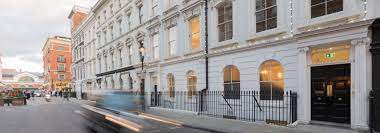Location:Charing Cross
Office Space near Charing Cross
Charing Cross office space is sought by those seeking space in Central London because it has long been deemed the official centre of London.
Since the 17th century, Charing Cross has been an agreed-upon central datum point from which road distances from London have been measured. Various acts, including the London Hackney Carriage Act 1831 and the London Building Act 1844, also reference it and its surrounding district to define the centre of the United Kingdom’s capital city.
The history of Charing Cross goes back much further, however. In 1290, when the Queen of England, Eleanor of Castile, died, her husband, King Edward I, ordered a 21-day funeral procession from Lincoln through the heartland of Eleanor’s properties, culminating in her body’s burial at Westminster Abbey.
The procession would stop at 12 locations with an ‘Eleanor Cross’ monument to be erected at each.
The grandest was built in the village of Charing, named after the olde English term depicting a ‘Riverbend’ because it was located on a prominent bend in the River Thames.
This cross stood where the King Charles I statue stands today, south of Trafalgar Square. This location is designated as the datum point for the centre of London today.
The majority of the Eleanor Crosses, including the one in London, were destroyed by Parliamentarians during the First English Civil War, which lasted from 1642 to 1651. However, three of the originals in Geddington, Northampton, and Waltham survive today.
The London cross was replaced by the statue of King Charles I in 1675. The replacement Eleanor Cross, designed by Edward Middleton Barry and completed in 1865, was erected outside Charing Cross station, which he also designed.
The replacement cross was somewhat of an enhancement on the original and contains nine separate sculptures representing Queen Eleanor.
Today, Charing Cross is a junction in Westminster where six routes converge. Clockwise from north, the routes that meet at Charing Cross are the east side of Trafalgar Square leading to St Martin’s Place and then Charing Cross Road, the Strand leading to the City of London, Northumberland Avenue leading to the Thames Embankment, Whitehall leading to Parliament Square, The Mall leading to Admiralty Arch and Buckingham Palace, and two short roads leading to Pall Mall.
A wide range of high-quality office spaces are available to rent near Charing Cross. Those within easy walking distance offer prime business accommodation options within amenity-rich buildings.
In addition to traditionally leased offices, there is a growing number of premium flexible office space and workspace options in Charing Cross as there are across the whole of Central London.
These include private serviced offices and pre-fitted and furnished managed offices in various sizes. Available private office suites and floors are suitable for workspaces for between two desks and 250 desks.
These agile office space options are available on flexible licence agreements, which are shorter in term and less onerous than a conventional lease. Due to their flexibility, the occupying client can also easily modify their footprint in line with changing business needs.
The licensed offices are paid for through once-monthly all-inclusive rental payments that cover items such as utilities, cleaning, reception services, service charges, enterprise-grade internet services, security, and other overheads that would typically be paid for and managed separately if renting an office in Charing Cross in the conventional leasehold manner.
Many of the prime office buildings in the locale also offer meeting rooms and boardrooms that can be booked ad hoc and communal amenities such as breakout rooms, kitchens, and quiet zones.
Many also offer bicycle storage, showers, and changing facilities for those who wish to use their own steam to commute to the office.
However, Charing Cross railway station and Charing Cross Underground station (CHX) offer multiple services and, together, serve over 30 million passengers annually.

